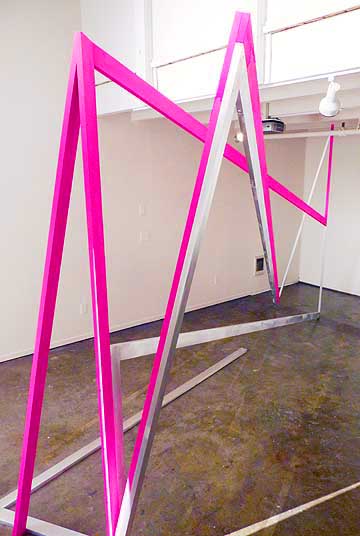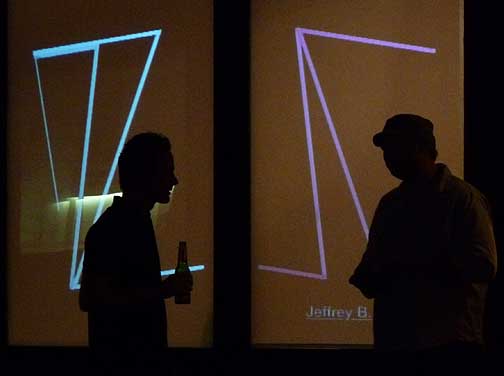
|
||
|
Portland art blog + news + exhibition reviews + galleries + contemporary northwest art
|
||
Jordan Tull's debut at Tractor Gallery  Tull's Reflexion, aluminum (2009) Jordan Tull's Reflexion marks another exciting introduction at Tractor Gallery, which has lately become the place in Portland for new installation artists to make a serious debut (pointed out by PORT and menton in the New York Times before other local sources). What's more the level of ambition in the aluminum fabrication here puts most other Portland art spaces to shame (this isn't an indie aesthetic at all). Thus, Tull's effort really stands out, even in comparison to other Tractor shows. For example, instead of simply having the work fabricated for him Tull did the work himself collaborating with a CAD design programmer to achieve today's ridiculous (but industrially typical)levels of precision. It's no surprise though, Tull is a master metalsmith who did a much of the lighting restoration/fabrication in the Portland Art Museum's Mark Building. That said, his work is considerably more contemporary at Tractor. Back to the work at hand, Reflexion consists of interlocking and triangulated aluminum beams, which reflexively mirror each other in pink and raw aluminum versions. Like dopplegangers from alternate but intersecting universes they act as structural supports for one another. In fact, the piece is bolted to the floor in only one spot, another impressive bit of engineering.  Reflexion video animations The videos (visible when the sun goes down) are animations derived from the CAD designs used to produce the piece and though I don't think they are entirely necessary they do add an additional element to the exhibition. Philosophically this piece is about the production of and consumption of space as a repetitive act both as a computer schematic and as a finished form in relation to that schematic. Call it the tension between the plan and the final product.... or a mirrored relationship between virtual intent and actual effect (something that Wii games traffic in).  Reflexion (detail) The resulting effect is the viewer's heightened awareness of both the space and the limitations of that finite resource (an existential condition if there ever was). It reminds me somewhat of Sir Anthony Caro's Strip Stake at the Portland Art Museum, but differs in that Reflexion isn't terribly invested in being an object… but as a project completed. In particular, the way Reflexion interacts with the double and single height ceilings of the space is nuanced, with a feeling that is both liberated and constrained at the same time… The sculpture seems both too big and too small for the space… it's like a chatty neighbor; sometimes interaction breaks monotony between fence lines, sometimes it enforces it or makes you wish it were a more solid barrier. 
Anthony Caro, Strip Stake, 1971-1974, steel, The Clement Greenberg Collection; Portland Art Museum Purchase: Funds Provided by Tom and Gretchen Holce, 2001.1.17 © Anthony Caro Overall though, Reflexion doesn't break any new ground so much as update the historic Anthony Caro/Clement Greenberg lexicon with nods to deconstructionist architecture (Jean Nouvel, Toyo Ito etc.) through use of precision fabrication software like Rhino. The difference from Caro is that instead of form as a singular act of material/lyrical construction Tull's effort is form as an act of premeditated design and refined fabrication. Thus, there is little emphasis on the handmade aspects or precious patinas like Caro and is more in the tradition of Donald Judd's small shop industrial fabrication. Yet, Judd would avoid the nifty looking inset hex head screws as too attention getting. Cool fasteners might be something Tull could explore at a later date…it would further separate him from Judd. I suspect those with a well developed appreciation for design will like this exhibition and Reflexion is further evidence that this newest wave of Portland artists are capable of being a lot more than self conscious. Tull might not be the master sculptor Caro was… but his levels of ambition here cause me to wonder where he might take this work in the near future. Posted by Jeff Jahn on August 06, 2009 at 17:12 | Comments (0) Comments Post a comment Thanks for signing in, . Now you can comment. (sign out)
(If you haven't left a comment here before, you may need to be approved by
the site owner before your comment will appear. Until then, it won't appear
on the entry. Thanks for waiting.)
|
| s p o n s o r s |
 |
 |
 |
 |
 |
 |
 |
 |
 |
 |
 |
 |
 |
 |
 |
 |

|
Site Design: Jennifer Armbrust | • | Site Development: Philippe Blanc & Katherine Bovee | |

